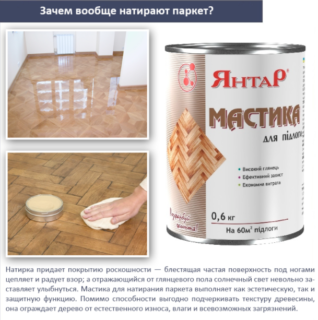Wood flooring is one of the most common flooring options. The material is lightweight, affordable, available in a wide variety of forms - boards, parquet, modules. However, the tree is sensitive to changes in humidity and temperature, so such a floor must be properly cared for.
Properties of wood flooring
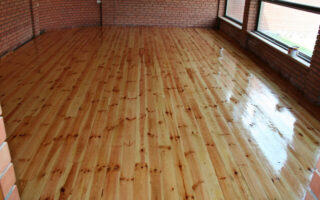
Wood is a unique building material. It is used both for the construction of load-bearing structures and for interior and exterior decoration. Wooden floors have a lot of undeniable advantages:
- Natural wood is very beautiful. The richest selection of colors and patterns allows you to choose the ideal option for any style, any interior and any size of the room.
- Wood keeps you warm and stays warm to the touch.
- Material dampens sound. Footsteps and jumps are not audible throughout the house.
- The tree is easy to handle. It is planed, polished, polished at home.
- The price of the material is quite affordable, but depends on the breed.
- Hardwood floors - oak, beech, hornbeam, serve for centuries. But the ordinary covering of pine boards retains its practicality and beauty for decades.
Wood also has disadvantages:
- It is a flammable and therefore fire hazardous material. In dwellings they resign themselves to this deficiency.
- Wood changes volume by absorbing and evaporating moisture. In the kitchen, floors can swell due to high humidity, and in the living room they dry out under the influence of the sun.
- At high humidity, a tree of medium and low density loses its strength, molds, and decays. The material must be protected.
- Overdried wood often falls prey to insects and rodents.
The disadvantage is not too high mechanical strength. By contrast, hardwood floors are exceptionally durable and hard.
You can neutralize most of the disadvantages of the coating with the right care.
Variety of products for covering wooden floors
Correctly chosen impregnation for a wooden floor in the country or in the house is a universal way of care. The agent is absorbed into the top layer of a board or parquet and forms a water-repellent film on its surface. Usually, these same compounds prevent the appearance of insects, although they do not save them from rodents.
Many of the impregnations have good aesthetic properties. Oiled or waxed parquet looks well-groomed and beautiful, even if it is over 100 years old.
Wax
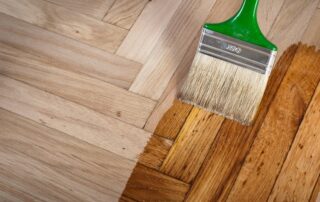
The basis of the wax is paraffin. Outwardly, the product resembles candied honey - very thick and viscous, more dense than butter. The wax does not change the color of the material, but gives it a silky soft sheen.
The substance penetrates only into the top layer of wood, strengthening and compacting it. Thus, the mechanical strength of the coating is increased. Wax creates a water-repellent film: this is enough for living rooms and kitchens.
The coating is resistant to alcohols, so that the parquet after the procedure can be washed with both water and special chemicals. It is necessary to repeat the treatment 2-3 times a year, otherwise the coating loses its protective properties.
A previously cleaned and dry surface is covered with wax. For a liquid composition, use a brush, rub the paste with a cotton cloth. After drying, the parquet is polished. The coating dries for about a day.
The wax forms a vapor-permeable film that allows the wood to "breathe".
Butter
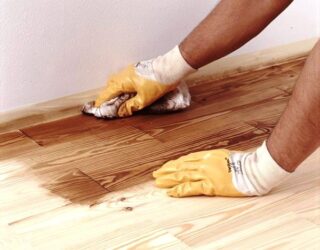
The product is more liquid in consistency, viscous, odorless and colorless. The oil impregnates the upper and middle layers of the wood, gradually penetrating into the pores of the wood and creating not a film, but rather a water-repellent structure.
The coating does not increase damage resistance, but it does make minor scratches and abrasions invisible. The oil protects against the action of dyes, alcohols, weak acids and alkalis. At the same time, the substance does not close the pores, so the tree "breathes".
The composition creates a soft, barely noticeable shine after absorption. Over time, the impregnation makes the wood shade darker and more saturated. If the covering is made of light wood, it is better to choose a different method of care.
Although oil is antistatic, it attracts dirt and dust more than varnish or wax - floors need to be washed or vacuumed more often. It is undesirable to put metal structures on such a floor: the metal reacts with the coating, dark irreparable stains remain on the floor.
The substance is rubbed into the floors with a cotton cloth. It takes 3-4 days for complete absorption.
Wood species containing a large amount of oily substances - lapacho, kempas, iroko, as well as wood prone to warping - birch, must be treated with oil.
Varnish
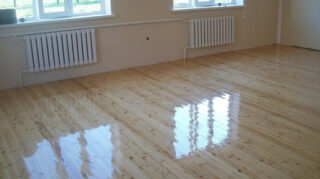
Varnish is a viscous liquid substance based on resins, polyurethane, and other synthetic and natural components. The liquid varnish is applied to the floor with a brush. When dry, the solvent evaporates, and the binder polymerizes, forming a thin water-repellent film on the surface. Oil-based varnishes are also produced: such compositions need to be prepared, applied more carefully, they dry longer.
Varnishes are varied. Most often, they create a transparent, glossy finish. However, there are matte, glossy and semi-glossy compositions. In addition, they offer toning mixtures - they change the shade of the wood, emphasize the pattern. There are even glitter compositions.
The varnish protects the wood from the action of water and steam, and prevents mold. However, the protective film is very thin and easily damaged, so the varnish must be renewed frequently.
The varnish creates an impervious film. The tree underneath does not "breathe". Lacquered floors are more likely to dry out, squeak and deteriorate faster.
Paint
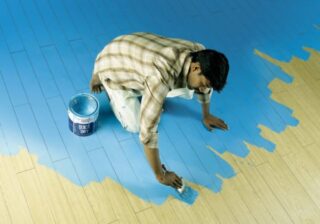
The principle of action of paints is the same as that of varnish. When dry, the solvent evaporates, the binder polymerizes, and the pigments give the coating a certain color. Paints with good hiding power completely hide the wood pattern, even the wood texture. Transparent ones change their shade.
It is possible to cover the wooden floor inside the apartment or in the country house only with safe compositions suitable for interior decoration. These are oil, acrylic or alkyd paints. Their characteristics are different. Oil oils are durable, but dry for a long time. Acrylic has a high hiding power, but is sensitive to moisture and is not suitable for the bathroom.
Before painting, the tree is treated with a primer. Wood is a porous material and absorbs a large amount of matter without leaving a trace. The primer reduces paint consumption.
You can paint not only boards, but also laminate, plywood and even linoleum.
Mastic
The mastic significantly increases the resistance to steam, water and temperature changes. It is recommended to use this compound on floors in the kitchen, bathroom and toilet on any floor. At the same time, the coating creates a soft beautiful shine, so it is quite suitable for the living room.
Preparatory work
Preparation for any coating is very simple:
- Remove the old coating - the paint is dissolved or removed with a spatula if it is old. A layer soaked in wax or simply destroyed is removed with a grinder.
- If mold, rot, other damage is found, the boards or planks of the parquet are removed and replaced with new ones.
- It is recommended to polish old floors or new ones, but not too high quality.
- The flooring is treated with antiseptic impregnation, fire retardants, paint primer, if painting is expected.
The finishing primer and the selected finishing material must be matched. The varnish should not be applied over oil impregnation.
Required tools and materials
To process floors you will need:
- brushes - wide, narrow, rollers, for applying varnish, paint, liquid wax;
- cuts of cotton cloth for grinding pastes and hard wax and for sanding the coating;
- filler with sawdust for filling cracks and scratches;
- finishing material - varnish, paint, wax.
When working with some paints and varnishes, you will need protective clothing: an apron, glasses, gloves.
Wood floor coating technology
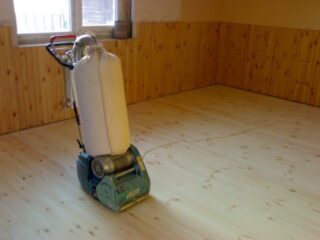
The general scheme of floor treatment is simple.
- Prepare the room: take out furniture, repair floors, clean.
- Choose a primer for varnish or paint. It depends on the type of wood. Oak requires a special cut-off primer, as the tree is rich in tannins. Exotic breeds require a mixture that condenses the action of essential oils.
- Work begins at a temperature of + 12– + 25 C. Use brushes or rollers, a spray gun is allowed. The floor is painted with a brush sequentially, stroke by stroke, varnish - in cruciform movements.
- After drying 1 layer, apply 2. It is advisable to grind 1 layer after hardening, and then, removing the dust, repeat the staining.
- Wait until the coating is completely dry. If the floor feels sticky afterwards, wash it with soapy water.
The wooden floor needs protection. A variety of compounds are used for this: paints, varnishes, mastic, oil. Each tool has its own pros and cons, which must be considered when choosing.

